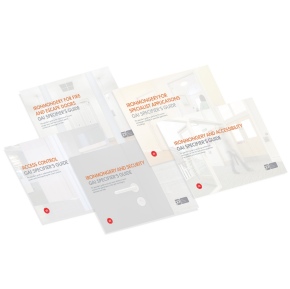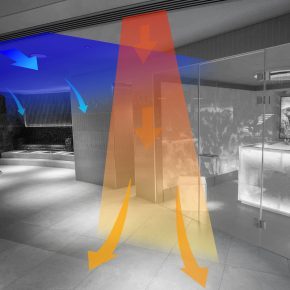
The GAI simplifies the specification process with new ironmongery guides
The Guild of Architectural Ironmongers (GAI) has launched five new guides on architectural ironmongery for different applications, giving easy access to the latest, best practice advice.
The GAI is the body that represents the interests of the UK architectural ironmongery industry. Its qualifications, education and CPD programmes are widely respected in the UK and overseas. Its technical information service is the only specialist service of its kind and provides GAI members with comprehensive advice.
Based on the RIBA approved CPD presentations created by the GAI, each guide contains comprehensive product information, diagrams and detail on the relevant building regulations and industry standards. All of the guides are available to download for free from the GAI website.
Douglas Masterson, technical manager at the GAI, explains: “We recognise that specifying architectural ironmongery can be complex, so we’ve pulled together all of the information an architectural ironmonger will need to ensure the hardware is not only compliant but also performs as expected and suits the environment it is being used in.”
The Specifier’s Guide to Ironmongery and Security helps specifiers to navigate security issues that they may face relating to doors. The guide covers mortice locks, including a breakdown of the main types of mortice locks and where they can be used. It also includes the different shapes of cylinders and how they work within a master key system, and electronic locks that can be used as part of an access control system.
It also provides an in-depth look at PAS 24, Approved Document Q, relevant British and European Standards, and industry certification schemes. The guide has been endorsed by Secured by Design, the official UK Police security initiative.
The Specifier’s Guide to Access Control is designed to give a comprehensive overview of the role of access control, covering how to specify access control products and systems.
It contains a helpful guide to the questions that need to be asked when specifying an access control system, and the order that access control product should be specified in a building. There is also a checklist for reviewing the system that is being specified.
The Specifier’s Guide to Ironmongery and Accessibility outlines the best practice guidelines of accessible and inclusive design. As well as covering all of the relevant ironmongery, the guide includes information on the dimensional guidelines required for lever and pull handles, locks, keys, thumb turns and handrails to be compliant with BS 8300.
It also covers specifying ironmongery and signage that has strong visual contrast and light reflective value (LRV) to assist those with visual impairments to meet BS 8300 guidelines, as well as legislation that applies specifically to this area of architectural ironmongery. This includes the Equality Act and guidance documents to building regulations on accessibility throughout the UK and Ireland, including Approved Document M.
The Specifier’s Guide to Ironmongery for Specialist Applications helps specifiers choose the correct ironmongery solutions for specialist applications in public buildings such as schools, care homes and hospitals.
The guide gives information on accessibility regulations that impact the specification of ironmongery including specialist closing devices, door automation, visual contrast and light reflectance value (LRV). It also covers more specific hardware solutions such as anti-ligature hardware, anti-microbial door furniture, finger protection and specialist signage, detailing relevant product information, current standards and best practice.
The Specifier’s Guide to Ironmongery for Fire and Escape Doors emphasises the critical role of fire and escape doors and the importance of correctly specified architectural ironmongery. It explains different types of fire and escape doors and details the corresponding essential ironmongery, seals and signage including the standards that they must adhere to. It also contains a useful guide to the questions that need to be asked when specifying hardware for escape doors, as well as further guidance on fire door inspections and ongoing ironmongery maintenance.
Click here to download the guides for free.
Visit Supplier's page
Latest news

1st April 2025
Gilberts Takes Thermal Comfort to New Heights
Gilberts Blackpool is continuing to build on its reputation as a pioneer with the unveiling of ThermaAstute™ – the most extensive range of thermally sensitive diffusers in the market.
Posted in Air Conditioning, Articles, Building Industry News, Building Products & Structures, Building Services, Facility Management & Building Services, Heating, Ventilation and Air Conditioning - HVAC, Innovations & New Products, Restoration & Refurbishment, Retrofit & Renovation, Sustainability & Energy Efficiency
1st April 2025
University of Bath Student Helps Vent-Axia Win Two Environmental Industry Awards
Leading ventilation manufacturer, Vent-Axia, is delighted that the valuable work University of Bath student Roben Els undertook during an industry placement at the company contributed to it winning two environmental industry awards.
Posted in Air Conditioning, Articles, Awards, Building Industry Events, Building Industry News, Building Products & Structures, Building Services, Heating, Ventilation and Air Conditioning - HVAC, Recruitment, Retrofit & Renovation, Sustainability & Energy Efficiency, Training
1st April 2025
Ahmarra: Fire Doors Designed for Hospitals & Healthcare Environments
Ahmarra is a leading UK specialist in fire doors for healthcare environments, having manufactured and installed thousands of bespoke doorsets for NHS hospitals across London and the South East.
Posted in Access Control & Door Entry Systems, Accessibility, Acoustics, Noise & Vibration Control, Architectural Ironmongery, Articles, Building Industry News, Building Products & Structures, Building Services, Building Systems, Doors, Facility Management & Building Services, Health & Safety, Interior Design & Construction, Interiors, Restoration & Refurbishment, Retrofit & Renovation, Security and Fire Protection, Timber Buildings and Timber Products, Wooden products
1st April 2025
Mitsubishi Electric: New intuitive, IoT-ready centralised controller offers instant access to 400 units
Mitsubishi Electric has launched a new user-friendly, touchscreen controller to offer full remote controllability, monitoring and reporting for up to 400 air conditioning units.
Posted in Air Conditioning, Articles, Building Industry News, Building Products & Structures, Building Services, Facility Management & Building Services, Heating Systems, Controls and Management, Heating, Ventilation and Air Conditioning - HVAC, Information Technology, Innovations & New Products, Pipes & Fittings, Plumbing, Posts, Research & Materials Testing, Retrofit & Renovation, Sustainability & Energy Efficiency
 Sign up:
Sign up: